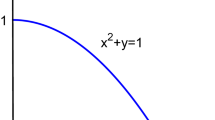Abstract
In this paper, the definition of generalized discrete fuzzy numbers is introduced, and a representation theorem of such fuzzy numbers is obtained. Based on the representation theorem, it is shown that the usual addition and multiplication which are defined by Zadeh’s extension principle do not preserve the closeness of the operation, and a new addition operation and a new multiplication operation are defined, which not only preserve the closeness of the operation, but also are easy to calculate. Then some weak orders on the generalized discrete fuzzy number space are defined, and their properties are investigated. At last, a practical example is given to show the application of the algorithmic version to rank uncertain or imprecise discrete quantity.
Similar content being viewed by others
References
Zadeh, L.A.: Fuzzy sets. Inf. Control 8(3), 338–353 (1965)
Chang, S.S.L., Zadeh, L.A.: On fuzzy mappings and control. IEEE Trans. Syst. Man Cybernet 2, 30–34 (1972)
Dubois, D., Prade, H.: Operations on fuzzy numbers. Int. J. Syst. Sci. 9, 613–626 (1978)
Dubois, D., Prade, H.: Towards fuzzy differential calculus, part 1: integration of fuzzy mapping. Fuzzy Sets Syst. 8, 1–17 (1982)
Chen, S.J., Lee, C.H.: New methods for students’ evaluation using fuzzy sets. Fuzzy Sets Syst. 104(2), 209–218 (1999)
Wang, G., Shi, P., Messenger, P.: Representation of uncertain multichannel digital signal spaces and study of pattern recognition based on metrics and difference values on fuzzy cell number spaces. J. IEEE Trans. Fuzzy Systemsvol. 17(2), 421–439 (2009)
Wang, G., Shi, P., Wang, B., Zhang, J.: Fuzzy-ellipsoid numbers and representations of uncertain multichannel digital information. J. IEEE Trans. Fuzzy Syst. 22(5), 1113–1126 (2014)
Tian, Z., Hu, L., Greenhalgh, D.: Perturbation analysis of fuzzy linear systems. Inf. Sci. 180, 4706–4713 (2010)
Esi, A., Açıkgöz, M.: Some new classes of sequences of fuzzy numbers. Int. J. Fuzzy Syst. 13(3), 218–224 (2011)
Murshid, A.M., Loan, S.A., Abbasi, S.A., Alamoud, A.R.M.: A novel VLSI architecture for a fuzzy inference processor using triangular-shaped membership function. Int. J. Fuzzy Syst. 14(3), 345–360 (2012)
Dat, L.Q., Yu, V.F., Chou, S.Y.: An improved ranking method for fuzzy numbers based on the centroid-index. Int. J. Fuzzy Syst. 14(3), 413–419 (2012)
Chu, T.C., Charnsethikul, P.: Ordering alternatives under fuzzy multiple criteria decision making via a fuzzy number dominance based ranking approach. Int. J. Fuzzy Syst. 15(3), 263–273 (2013)
Moreno-Garcia, J., Linares, L.J., Rodriguez-Benitez, L., et al.: Fuzzy numbers from raw discrete data using linear regression. Inf. Sci. 233, 1–14 (2013)
Hong, D.H.: The law of large numbers and renewal process for T-related weighted fuzzy numbers on \(R^p\). Inf. Sci. 228, 45–60 (2013)
Nan, J.X., Zhang, M.J., Li, D.F.: Intuitionistic fuzzy programming models for matrix games with payoffs of trapezoidal intuitionistic fuzzy numbers. Int. J. Fuzzy Syst. 16(4), 444–456 (2014)
Arotaritei, D., Ionescu, F.: Fuzzy Voronoi diagram for disjoint fuzzy numbers of dimension two. J. Intell. Fuzzy Syst. 26, 1253–1262 (2014)
Coroianu, L., Gagolewski, M., Grzegorzewski, P.: Nearest piecewise linear approximation of fuzzy numbers. Fuzzy Sets Syst. 233, 26–51 (2014)
Voxman, W.: Canonical representations of discrete fuzzy numbers. Fuzzy Sets Syst. 118, 457–466 (2001)
Wang, G., Wu, C., Zhao, C.: Representation and operations of discrete fuzzy numbers. Southeast Asian Bull. Math 28, 1003–1010 (2005)
Casasnovas, J., Riera, J.V.: On the addition of discrete fuzzy numbers.” WSEAS Trans. Math, pp. 549–554 (2006)
Casasnovas, J., Riera, J.V.: Discrete fuzzy numbers defined on a subset of natural numbers. Theor. Adv. Appl. Fuzzy Logic Soft Comput. Adv. Soft Comput. 42, 573–582 (2007)
Casasnovas, J., Riera, J.V.: Maximum and minimum of discrete fuzzy numbers. Front. Artif. Intell. Appl. 163, 273–280 (2007)
Casasnovas, J., Riera, J.V.: Lattice properties of discrete fuzzy numbers under extended min and max. Proceedings IFSA-EUSFLAT, pp. 647–652 (2009)
Casasnovas, J., Riera, J.V.: Extension of discrete t-norms and tconorms to discrete fuzzy numbers. Fuzzy Sets Syst. 167(1), 65–81 (2011)
Riera, J.V., Torrens, J.: Aggregation of subjective evaluations based on discrete fuzzy number. Fuzzy Sets Syst. 191(16), 21–40 (2012)
Riera, J.V., Torrens, J.: Residual implications on the set of discrete fuzzy numbers. Inf. Sci. 247, 131–143 (2013)
Xie, Y., Wang, G., Wang, B.: The operation of 2-dimensional discrete fuzzy numbers. ICIC Express Lett. 7(11), 2921–2925 (2013)
Riera, J.V., Torrens, J.: Aggregation functions on the set of discrete fuzzy numbers defined from a pair of discrete aggregations. Fuzzy Sets Syst. 241, 76–93 (2014)
Massanet, S., Riera, J.V., Torrens, J., Viedma, E.H.: A new linguistic computational model based on discrete fuzzy numbers for computing with words. Inf. Sci. 258, 277–290 (2014)
Wang, H., Chen, S.: Evaluating studentsanswerscripts using fuzzy numbers associated with degrees of confidence. IEEE Trans. Fuzzy Syst. 16(2), 403–415 (2008)
Acknowledgments
This work was partially supported by the Nature Science Foundation of China (Nos. 61273077 and 61433001), the Nature Science Foundation of Zhejiang Province, China (No. LY12A01001).
Author information
Authors and Affiliations
Corresponding author
Rights and permissions
About this article
Cite this article
Wang, G., Wang, J. Generalized Discrete Fuzzy Number and Application in Risk Evaluation. Int. J. Fuzzy Syst. 17, 531–543 (2015). https://doi.org/10.1007/s40815-015-0038-z
Received:
Revised:
Accepted:
Published:
Issue Date:
DOI: https://doi.org/10.1007/s40815-015-0038-z




